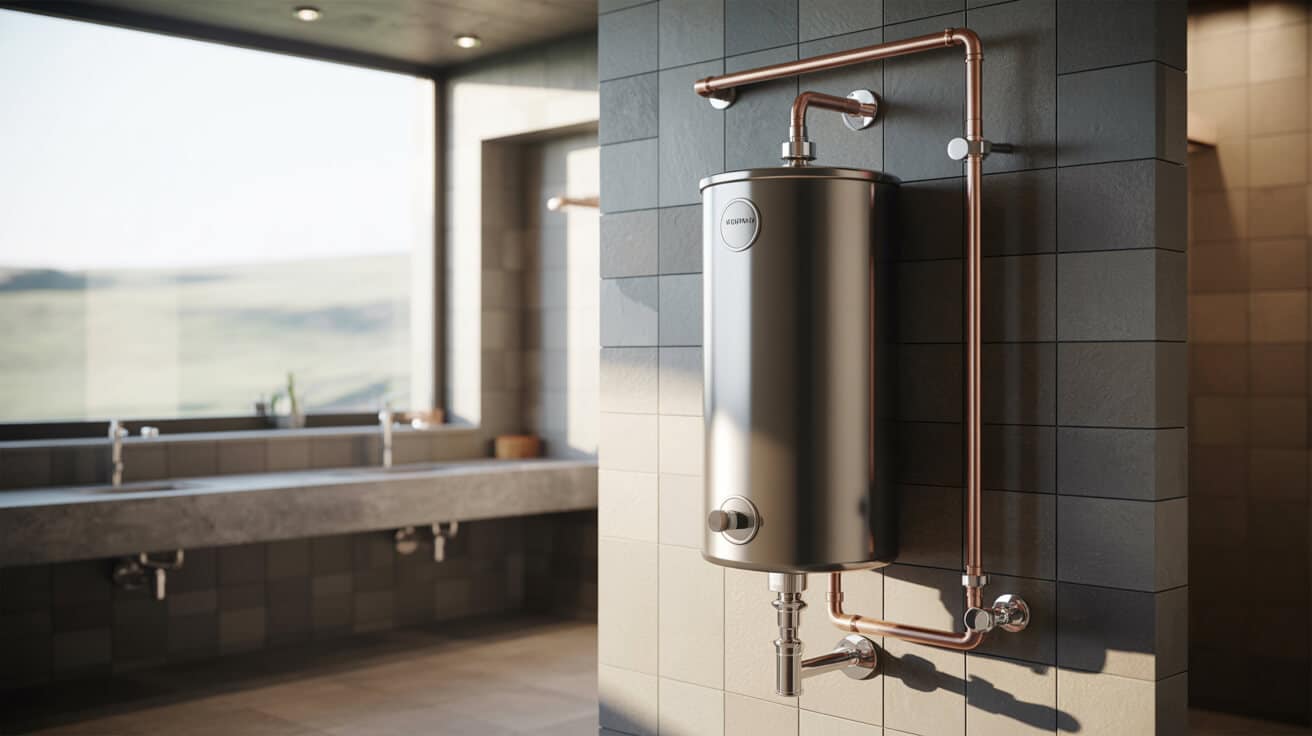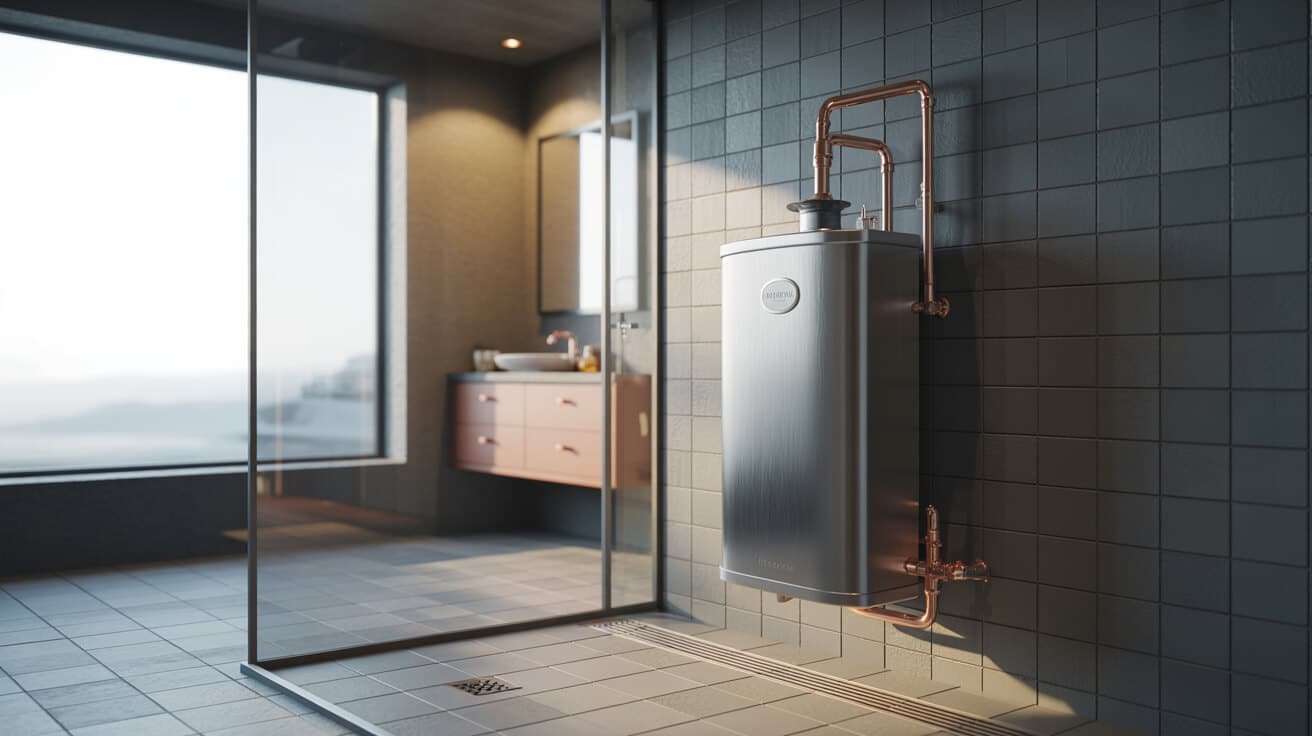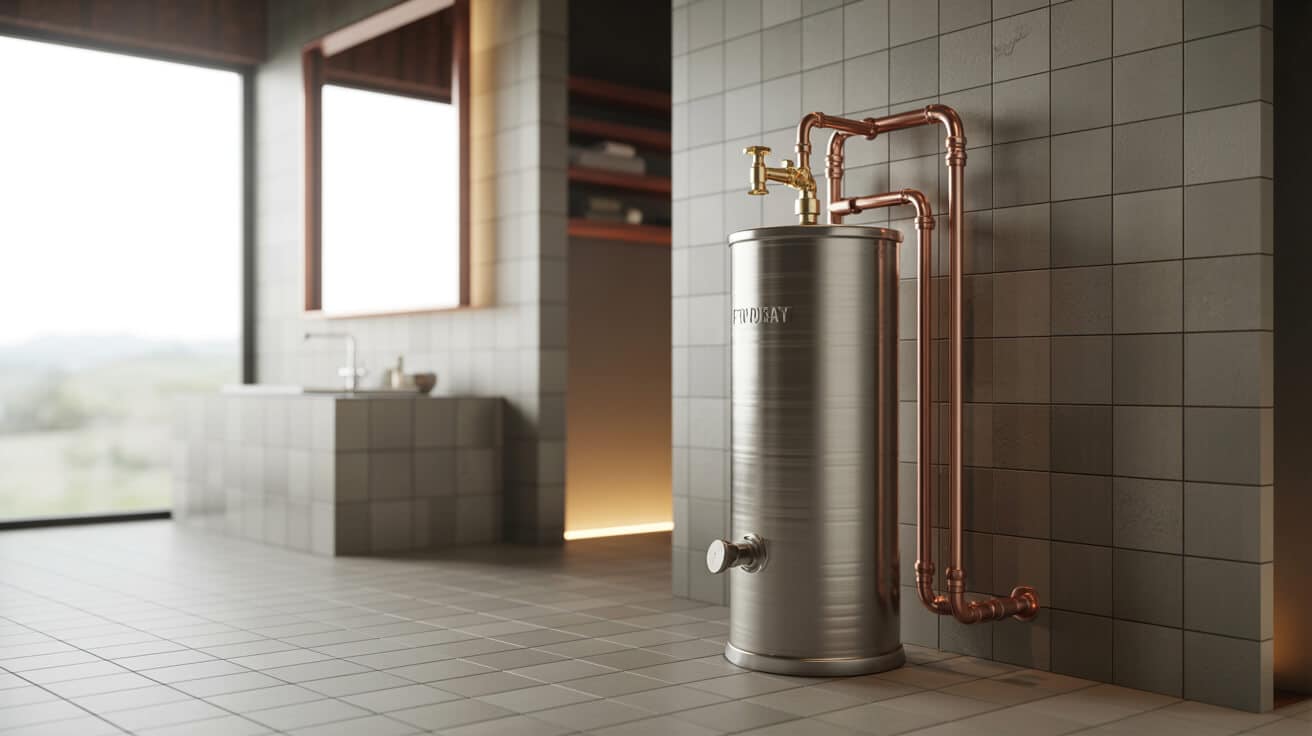Vented hot water cylinders function as the core of traditional hot water delivery systems, relying on gravitational pressure from a cold water storage cistern situated above the heated cylinder. Instead of utilising mains pressure, the system leverages natural head height to distribute hot water throughout the property. The arrangement inherently provides resilience to low or fluctuating water supply and enables simple, robust management of overpressure situations through an open vent pipe system.
These vessels, widely adopted in both older domestic properties and institutional complexes, support direct heating by an internal immersion element or indirect heating via external sources such as boilers or solar coils. Vented cylinders play a particularly important role in environments subject to regulatory constraints, architectural preservation mandates, or bespoke occupant demand patterns. Modern installations may include advanced insulation, renewable input adaptation, and digital monitoring, yet the system retains a straightforward maintenance and operational ethos. Firms like Plumbers 4U often maintain or upgrade existing vented hot water cylinder systems, prioritising regulatory compliance and the long-term integrity of your building’s water infrastructure.
Etymology or name origin
The nomenclature “vented hot water cylinder” reflects the system’s two principal features: its cylindrical tank design and reliance on a vent pipe that remains open to atmospheric pressure. This term arose to distinguish such systems from pressurised, “sealed” or “unvented” cylinders. Regionally, descriptors include “gravity-fed hot water tank,” “open-vent storage vessel,” and, in Ireland and Commonwealth countries, “open-system cylinder.” Historical trade literature references “ballcock-fed copper boiler,” as early designs commonly utilised copper for thermal conductivity and ease of manufacture. Across nations, variant terms include “cold water header tank system” or simply “header-fed system,” depending on local plumbing traditions.
Overview and context
Open-vented cylinder systems provide a robust solution in settings where main water pressure is low, variable, or requires decoupling from hot water supply. The system integrates three main elements: an insulated hot water cylinder, a cold water storage cistern in a loft or elevated service space, and an open vent pipe that connects the cylinder top to a point above the cistern.
This architectural choice is prevalent in areas relying on stored rainwater, private wells, or outdated municipal supply networks, reinforcing reliability independent from broader infrastructure shifts. Urban terraced houses, multi-tenanted conversions, and rural estates often feature legacy vented systems. They remain favoured for their tolerance to fluctuating water quality, compatibility with broad pipework geometries, and unique resistance to back-pressure or contamination. The system structure minimises cross-contamination risk by physically separating cold supply and hot draw-off lines, a feature of heightened importance in installations serving multiple self-contained residential units.
Property owners and facilities managers often select or retain vented systems based on regulatory compliance, preservation bylaws, or cost-effective maintenance strategies. As mains-pressurised alternatives increased in popularity, vented cylinders have retained loyalty in sites where reliability, simplicity, and flood resilience outweigh desires for high shower pressure or rapid hot water delivery.
History
Origins
The genesis of vented hot water storage traces to the late nineteenth and early twentieth centuries. Communal cisterns and early hand-filled copper tanks were supplanted by household-specific storage vessels, offering occupants the convenience of on-demand heated water. This shift closely paralleled urbanisation, expansion of municipal water supply, and advances in coal and later gas heating technologies.
Industrial emergence
In mid-twentieth-century Britain, the open-vented system achieved ascendancy in standard building practice. Guarantees of supply, improved sanitation, and insurance of water availability drove adoption. The copper vented cylinder became ubiquitous, featured in both modest council estates and grander private homes. Integration with oil, coal, or back-boiler outputs allowed residents to heat water using nearly any available fuel, fostering adaptability and resilience. As piped natural gas networks expanded and central heating became the norm, designs incorporated indirect heating coils to connect with new boiler systems.
Contemporary evolution
Current designs have responded to the increasing emphasis on energy efficiency, water conservation, and public health. Regulatory advances, such as BS 6700 and Water Supply (Water Fittings) Regulations 1999, refined performance and safety benchmarks. The 1980s introduction of unvented, pressurised cylinders expanded the range of options for high-pressure hot water delivery, particularly in new construction. Nonetheless, open vented systems have remained a mainstay where architectural, legal, or practical considerations dictate a preference for atmospheric, gravity-fed operation.

Concept / description
System architecture
A vented hot water system incorporates these fundamental elements:
- Insulated hot water cylinder: Generally manufactured from copper or stainless steel, with an internal or external thermal insulation jacket. Standard volumes range from 90 to 450 litres, scaled to occupancy and demand.
- Cold water storage cistern: Installed at an elevation (typically attic/loft or plant room), this reservoir replenishes the cylinder via gravity. Fitted with a ballcock/float valve to regulate inflow and safeguard against overflow.
- Open vent pipe: Rises from the cylinder’s highest point, terminating above the cistern’s overflow level. Provides instantaneous pressure relief and safe venting for air or steam.
- Heating element: Direct systems use a resistive electrical immersion element. indirect systems leverage a primary coil connected to a remote boiler or renewable heat source.
- Distribution outlets: Hot taps, baths, showers, and appliances draw from the cylinder, with pipework layouts designed for minimal thermal or pressure loss.
- Ancillary controls: Thermostats monitor temperature, while drain cocks, thermostatic mixing valves, and expansion control components ensure function and safety.
Operational mechanics
- Water enters the cold cistern from the main supply and flows, under gravitational force, to the cylinder’s base as hot water is drawn.
- The vent pipe ensures atmospheric pressure at all times, with any excess air or heated expansion safely and quietly released.
- Water leaving the cylinder is replaced by an equal volume from the cistern, maintaining a constant equilibrium and supply buffer.
- The system’s capacity for backup heating—via an immersion element—offers occupants added security against boiler failures or programmed outages.
Material science and engineering
- Copper is prized for its antimicrobial properties, high thermal conductivity, and ease of repair. Stainless steel, although costlier, resists both internal and external corrosion, extends service life, and may be specified where water acidity is problematic or a higher working temperature is stipulated.
- Insulation has advanced from simple mineral wool wraps to rigid foam or vacuum panels, with compliance to Part L (fuel and power) of the Building Regulations ensuring minimised heat loss.
Functionality, purpose, and applications
Domestic environments
Vented systems characterise much of the UK’s postwar building stock, from terraced houses to grand period estates. Their inherent simplicity and resilience to fluctuating main supply make them reliable workhorses for household demand.
Commercial and institutional deployment
Schools, small hotels, and care homes employ open-vented installations when multiple draw-off points or zone distribution is needed without necessitating costly pressurisation risk controls. The system’s ability to supply many outlets simultaneously, albeit at a pressure strictly determined by tank height, aligns well with varied demand cycles.
Heritage and listed structures
In protected settings, modifications to water infrastructure often face strict planning controls. Vented systems are retained both for technical congruence with historic pipework and compliance with conservation guidance. Robust tolerance for variable water quality, freeze resistance (via overflow and vent routing), and low mechanical complexity position open-vent systems as a first-choice for sensitive estates or remote properties.
Operational complements and backup
The ability to utilise backup immersion heating—especially during main boiler servicing or supply failures—offers risk management for both property managers and private occupants. This feature is valued in winterization, planned outage, or emergencies, enhancing asset longevity.
Integration with ancillary systems
Modern vented cylinders interface with renewable energy sources via twin coils, are compatible with solar preheating and solid-fuel stoves, and support zone heating through distributed draw-off. The open venting guarantees inherent safety, minimising the risk of catastrophic vessel failure.
Classifications, types, and variants
Direct vented cylinders
Employed where an electrical immersion element is the exclusive heat source. Common in apartments, secondary heating, or backup/holiday accommodation. Simplicity and independence from complex heating infrastructure define usage.
Indirect vented cylinders
Use a heat exchanger (internal coil) connected to a central boiler. Suited for larger or primary residence applications, enabling efficient hot water production aligned with established heating cycles. Most modern cylinder storage follows this pattern, maximising boiler utilisation and operational savings.
Twin-coil and hybrid systems
These support dual or multi-source input, e.g., integrating solar or renewable input with traditional gas or oil-fired boilers. Plumbers 4U may recommend this approach for customers seeking energy savings or future proofing properties for eco-regulation compliance.
Cylinders with secondary return
Larger properties or commercial installations may use a pumped or gravity-fed return pipe to keep hot water continually circulating, eliminating draw-off latency or dead legs in extended pipework runs.
Cylinder material and format differentiation
- Copper, standard grade, or enamel-lined for improved durability
- Stainless steel for advanced corrosion resistance and longevity
- Horizontal or vertical orientation, determined by space constraints
Systems, tools, and methodologies
Installation methodologies
Professional installation of a vented hot water cylinder involves:
- Assessing cistern height and system head to ensure adequate pressure for all outlets.
- Sizing the cylinder to match occupancy, draw-off demand, and recovery rate.
- Specifying and routing open vent, overflow, and cold feed pipework in compliance with Building Regulations and Water Supply (Water Fittings) Regulations 1999.
- Integrating safety devices: thermostatic mixing valves, anti-scald devices, and expansion vessels as warranted.
- Using WRAS-approved materials and insulation to reduce energy loss.
- Completing benchmark certification and manufacturer sign-off.
- Finalising commissioning, leak testing, and thermal performance validation.
Servicing and maintenance protocol
- Scheduled inspection (visual and mechanical) of ballcock, overflow paths, insulation integrity, and immersion functionality.
- Periodic descaling and internal cleaning (especially in hard-water regions).
- Water quality monitoring for limescale or bacterial growth.
- Documentation of all works as required by landlord or facilities legislation.
Diagnostic techniques
- Pressure gauge measurement to verify system head and outlet performance.
- Temperature logging and verification at cylinder and distributed outlets.
- Leak tracing using dye or thermal imaging.
- Use of vent keys, pipework blanking, and continuity testers for airlock and blockage resolution.
Tools of the trade
- Pipe cutters and pipe benders for custom fit
- Vent keys for air release
- Insulation cutters and lagging wrap
- Pressure and temperature gauges
- Modern installations may also leverage digital loggers or wireless sensors for compliance and serviceability

Stakeholders and entities involved
Persona mapping and interaction
- Homeowners: Drive decisions on upgrade, replacement, and periodic servicing; value uninterrupted supply, ease of maintenance, and cost efficiency.
- Landlords and property managers: Accountable for regulatory compliance, contingency preparation (e.g., legionella management), and maintenance scheduling; regulatory and documentation requirements dictate service frequency and provider selection.
- Tenants and occupants: Directly affected by system performance; rely on the property owner and competent plumbing firms to ensure prompt, effective repairs and risk mitigation.
- Facilities managers: In commercial and institutional settings, oversee system performance, schedule planned maintenance, and negotiate contracts with vetted service providers, frequently upholding insurer-mandated inspection intervals.
- Plumbing engineers and contractors: Responsible for correct installation, routine servicing, and upgrades; enforce statutory compliance and record all work as stipulated in the Benchmark protocol. Plumbers 4U exemplifies an industry approach rooted in transparency, full compliance, and trust-driven best practices.
- Certifying bodies and regulatory agencies: WRAS, British Standards Institution (BSI), and HSE set technical, safety, and hygiene parameters, audit ongoing compliance, and conduct periodic technical reviews of installation and product standards.
Legal, regulatory, and ethical considerations
Building codes
- Part G of the Building Regulations: Mandates minimum storage temperatures, insulation, and system placement.
- Water Supply (Water Fittings) Regulations 1999: Addresses contamination prevention, material selection, and backflow control.
- Landlord and Tenant Act, Housing Health and Safety Rating System (HHSRS): For rented properties, guarantees provision of safe, reliable hot water; demands safety controls and records on legionella and scald risk.
WRAS and British Standards compliance
- All fixtures and fittings must be WRAS (Water Regulations Advisory Scheme) approved, ensuring compatibility with potable water and durability under operational loads.
- BS 6700/British Standards (replaced by BS EN 806): Codify design parameters such as pipe sizing, insulation, thermal performance benchmarks, and system longevity.
- Upgrades to unvented types, or significant repairs, invoke G3 certification; only eligible engineers may certify and sign off these works.
Certification and documentation requirements
- Full installation records, Benchmark logbooks, commissioning certificates, and safety checks are maintained by qualified service companies.
- Annual documentation ensures system insurance, warranty preservation, and legal compliance, especially for landlords and property managers.
Ethical and discretionary conduct
- Installers and suppliers such as Plumbers 4U uphold standards of transparency: clear invoicing, disclosure of maintenance schedules, open guidance on lifespan and replacement triggers, and proactive safety risk notifications.
- Suppliers safeguard client assets by specifying only suitable, WRAS-approved components, ensuring correct records are kept, and offering informed upgrade paths when warranted by technical or regulatory evolution.
Performance metrics, data, and measurements
| Metric | Description | Typical Range | SI Unit(s) |
|---|---|---|---|
| Storage capacity | Usable hot water per draw cycle | 90–450 | Litres |
| Gravitational head | Vertical distance, cistern-to-outlet | 1–3 | Metres |
| Operating pressure | Delivered at outlet, function of head | <0.3 | Bar |
| Heat-up time | Cold refill to target temperature | 20–120 | Minutes |
| Standby heat loss | Energy loss per 24h | 1.5–2.5 | kWh/day |
| Hot water draw-off temp | Typical delivered water temperature | 50–60 | °C |
| Flow rate | Through a standard bath or tap | 8–15 | L/min |
| immersion heater rating | Power of electric element | 2–3 | kW |
| Legionella control temp | Minimum set/performed temp holding | 60 | °C |
Performance is highly sensitive to cistern height, pipe run length, draw-off frequency, insulation quality, and regional water hardness.
Challenges, barriers, and limitations
Technical and operational barriers
- Water pressure dependency: Insufficient gravity head results in reduced flow, especially for showers and high-demand outlets.
- Airlocks and blockages: Common where draw-off lines contain upward loops or are of excessive length without regular use, requiring venting or pipework modification.
- Limescale accumulation and corrosion: In hard water areas, these factors accelerate maintenance intervals, can cause element failure, and shorten vessel lifespan.
- Space and placement constraints: Retrofits may be hindered by lack of loft space, structural limitations, or where modern construction norms prioritise compactness.
Economic and management challenges
- Upgrade triggers: High running costs, difficult-to-insulate tanks, or persistent maintenance may prompt owners to consider replacement with unvented or combi systems.
- Legal and insurance requirements: Landlords face increasing scrutiny, with stricter record-keeping and proof-of-service essential for tenancy agreements or claim defence.
- User expectations and education: Modern residents may not be familiar with limitations or management requirements for vented systems, amplifying user dissatisfaction if expectations are misaligned.
Social, regulatory, and cultural limitations
- Preservation requirements: Listed status or neighbourhood trust guidelines may prohibit system alteration, locking properties into open-vented configurations.
- Risk perception and compliance auditing: Insurers and local authorities may classify legacy systems as higher exposure, increasing compliance or remediation obligations.
Impact, influence, and legacy
Vented hot water cylinders have established the foundational standards from which contemporary building regulations and plumbing best practices are derived. Their continued role in training, compliance, and property insurance evidences ongoing practical relevance. For landlords, facilities directors, and homeowners alike, these systems represent a balance between regulatory safety, cost-effective operation, and risk mitigation.
Property portfolios under active management rely on professional plumbing partners like Plumbers 4U to ensure installations are serviced, recorded, and upgraded or replaced according to evolving expectations. The historic symbolism of vented systems as markers of reliability and adaptive engineering remains potent, particularly in regions where modernization is constrained by heritage or technical context.
Future directions, cultural relevance, and design discourse
Technological evolution
Anticipated trends in vented hot water technology include integrated digital sensors for remote performance monitoring and insurance compliance, improved insulation and materials for reduced standby heat loss, and hybrid renewable-compatible cylinders for sustainable property upgrades.
Sustainability and efficiency
Eco-conscious retrofit programmes may incentivize retention of vented systems through solar or heat pump integration, while regulatory schemes may tighten standards for heat retention and bacterial control, enhancing public health.
Cultural and heritage symbolism
For listed or architecturally sensitive buildings, retaining original system footprints is both a regulatory mandate and an act of cultural stewardship. Vented systems thus underpin not only functional supply but also a larger storey of housing continuity, resilience, and adaptation across generations.
Societal trends and market movement
As property management moves towards data-driven performance and predictive maintenance, vented systems must evolve to maintain relevance. Transparent documentation, rigorous safety oversight, and expert guidance from sector leaders such as Plumbers 4U will remain instrumental in shaping the responsible use and stewardship of these enduring assets.

